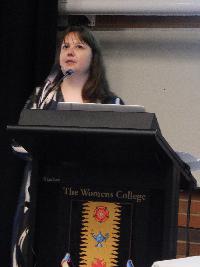Do you include all content when translating certificates? Thread poster: Steven Smith
|
|---|
Steven Smith
United Kingdom
Local time: 04:53
Member (2007)
Japanese to English
I have been asked to translate a birth certificate. The certificate includes marginal notes on how to fill it in. Is there a standard approach to this kind of content? Do you ignore it or include it in the translation for the sake of completeness?
Also, where the certificate contains a list of options and one has been selected or circled, should you still translate all options and mark the selected one, or just translate the selected one?
(In this case the translation ... See more I have been asked to translate a birth certificate. The certificate includes marginal notes on how to fill it in. Is there a standard approach to this kind of content? Do you ignore it or include it in the translation for the sake of completeness?
Also, where the certificate contains a list of options and one has been selected or circled, should you still translate all options and mark the selected one, or just translate the selected one?
(In this case the translation is to be certified and is for a passport application). ▲ Collapse
| | | | Andriy Yasharov 
Ukraine
Local time: 06:53
Member (2008)
English to Russian
+ ...
| Translate all content | Aug 27, 2017 |
What I do when translating a certificate is I translate all the content there is in a certificate, including any stamps, seals, notes, etc. and also I recreate the formatting of the certificate. It must resemble the original as close as possible, especially if it is to be certified and submitted to whom it may concern.
| | | | Maija Cirule 
Latvia
Local time: 06:53
German to English
+ ...
Andriy Yasharov wrote:
What I do when translating a certificate is I translate all the content there is in a certificate, including any stamps, seals, notes, etc. and also I recreate the formatting of the certificate. It must resemble the original as close as possible, especially if it is to be certified and submitted to whom it may concern.
my modus operandi is the same.
| | | | | You have to translate everything, | Aug 27, 2017 |
and format it in a way similar to the original. In some countries stamps are not translated, and neither are signatures, including the United States. You just put "stamp" in square brackets, or "signature illegible', or just "signature', like that [signature]. The original has always precedence over translation, and you should put that in your certificate of accuracy.
[Edited at 2017-08-27 09:51 GMT]
| | |
|
|
|
Andriy Yasharov wrote:
What I do when translating a certificate is I translate all the content there is in a certificate, including any stamps, seals, notes, etc. and also I recreate the formatting of the certificate. It must resemble the original as close as possible, especially if it is to be certified and submitted to whom it may concern.
You have to reproduce everything as stated in the original document, even spelling errors...
| | | | Kay Denney 
France
Local time: 05:53
French to English
| if you don't | Aug 27, 2017 |
if you don't translate everything the client will wonder why. They need a translation because they don't understand. It's not up to you to say whether or not the fine print is important or relevant.
in a list where one option has to be ticked, it could be that no option really corresponds so they ticked the nearest one. The choice is meaningless if you can't see that the true situation has not been listed (for example male or female when the person is in fact intersex or transition... See more if you don't translate everything the client will wonder why. They need a translation because they don't understand. It's not up to you to say whether or not the fine print is important or relevant.
in a list where one option has to be ticked, it could be that no option really corresponds so they ticked the nearest one. The choice is meaningless if you can't see that the true situation has not been listed (for example male or female when the person is in fact intersex or transitioning) ▲ Collapse
| | | | Jack Doughty 
United Kingdom
Local time: 04:53
Russian to English
+ ...
In memoriam
At one time I used to put "Printing details omitted" for patents and certificates (the small print at the end telling you how big a print run, the name of the publishing house etc.)., but I had demands to include this so now I always do.
| | | | Samuel Murray 
Netherlands
Local time: 05:53
Member (2006)
English to Afrikaans
+ ...
Teresa Borges wrote:
You have to reproduce everything as stated in the original document, even spelling errors...
How do you do that? Do you choose a word in the target text that is the translation of the misspelt source text word, and then misspell it in the target language? (-:
I wonder... is there an equivalent to "[sic]" that one can use to indicate that the target text word is simply the most likely translation of a misspelt word in the source text? I find that while some types of certificates (generated by a certain class of lazy or incompetent civil servant) often contain spelling errors, a translator who is experienced in translating such documents would be able to guess what the author meant. If the text mentions a "commissioner of oafs" (a real-world example, by the way!), will you really, really translate it as "oafs", or as "oaths"?
| | |
|
|
|
| Sic is the answer... | Aug 27, 2017 |
Samuel Murray wrote: Teresa Borges wrote:
You have to reproduce everything as stated in the original document, even spelling errors... How do you do that? Do you choose a word in the target text that is the translation of the misspelt source text word, and then misspell it in the target language? (-: I wonder... is there an equivalent to "[sic]" that one can use to indicate that the target text word is simply the most likely translation of a misspelt word in the source text? I find that while some types of certificates (generated by a certain class of lazy or incompetent civil servant) often contain spelling errors, a translator who is experienced in translating such documents would be able to guess what the author meant. If the text mentions a "commissioner of oafs" (a real-world example, by the way!), will you really, really translate it as "oafs", or as "oaths"?
If I remember correctly over a 20 year period as a sworn translator in Brussels it happened twice, one mistake concerned a birth date (the year was obviously wrong) and a Portuguese surname (one letter was missing). A sworn translator has to testify to the truthfulness of his/hers translation...
| | | | Vanda Nissen 
Australia
Local time: 13:53
Member (2008)
English to Russian
+ ...
| Depends on the country | Aug 28, 2017 |
I think it depends on the country. In Australia, authorities sometimes accept so-called extract translation for standard documents like birth certificates. To be perfectly honest, I've never tried it but I know a lot of colleagues who use this type of translations.
| | | |
Teresa Borges wrote: Samuel Murray wrote: Teresa Borges wrote:
You have to reproduce everything as stated in the original document, even spelling errors... How do you do that? Do you choose a word in the target text that is the translation of the misspelt source text word, and then misspell it in the target language? (-: I wonder... is there an equivalent to "[sic]" that one can use to indicate that the target text word is simply the most likely translation of a misspelt word in the source text? I find that while some types of certificates (generated by a certain class of lazy or incompetent civil servant) often contain spelling errors, a translator who is experienced in translating such documents would be able to guess what the author meant. If the text mentions a "commissioner of oafs" (a real-world example, by the way!), will you really, really translate it as "oafs", or as "oaths"? If I remember correctly over a 20 year period as a sworn translator in Brussels it happened twice, one mistake concerned a birth date (the year was obviously wrong) and a Portuguese surname (one letter was missing). A sworn translator has to testify to the truthfulness of his/hers translation...
What I do in such cases is to mention there is a typo or something like that.
That's what we have to do in Germany [Translator's note: the date n the original is wrong....]
| | | |
Absolutely, of course.
P.S. As the translation is to be certified, you might like to find out whether there are official guidelines for the UK that apply.
[Edited at 2017-08-28 22:09 GMT]
| | |
|
|
|
eyepod (X) 
United States
Local time: 20:53
English to Spanish
+ ...
| for legal documents | Aug 28, 2017 |
LilianNekipelov wrote:
and format it in a way similar to the original. In some countries stamps are not translated, and neither are signatures, including the United States. You just put "stamp" in square brackets, or "signature illegible', or just "signature', like that [signature]. The original has always precedence over translation, and you should put that in your certificate of accuracy.
[Edited at 2017-08-27 09:51 GMT]
I always say "signature illegible". Can't remember the reason when I was studying translation at university, something about liability I think. I do the same for sight translations for court documents.
| | | | neilmac
Spain
Local time: 05:53
Spanish to English
+ ...
| UK guidelines | Aug 30, 2017 |
Nikki Scott-Despaigne wrote:
P.S. As the translation is to be certified, you might like to find out whether there are official guidelines for the UK that apply.
[Edited at 2017-08-28 22:09 GMT]
And how might one, especially a newbie, go about that? Well, you could try Google.
I found this: https://www.gov.uk/certifying-a-document
However, although I only glanced at it briefly, it doesn't seem to say anything about whether every iota of the document content, whether relevant or not, needs to be translated...
| | | | To report site rules violations or get help, contact a site moderator: You can also contact site staff by submitting a support request » Do you include all content when translating certificates? | Anycount & Translation Office 3000 | Translation Office 3000
Translation Office 3000 is an advanced accounting tool for freelance translators and small agencies. TO3000 easily and seamlessly integrates with the business life of professional freelance translators.
More info » |
| | TM-Town | Manage your TMs and Terms ... and boost your translation business
Are you ready for something fresh in the industry? TM-Town is a unique new site for you -- the freelance translator -- to store, manage and share translation memories (TMs) and glossaries...and potentially meet new clients on the basis of your prior work.
More info » |
|
| | | | X Sign in to your ProZ.com account... | | | | | |













